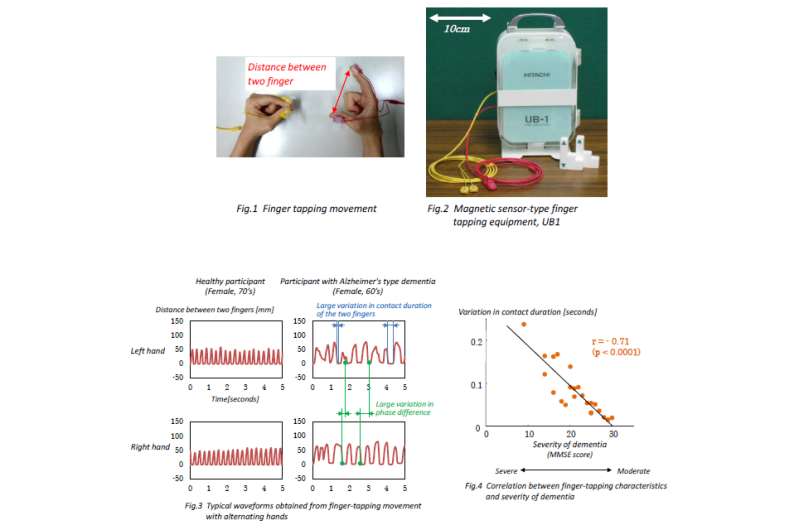Successful extraction of Alzheimer's-type dementia finger-tapping pattern

The National Center for Geriatrics and Gerontology ("NCGG") in Japan has succeeded in identifying an index finger-thumb tapping pattern unique to Alzheimer's-type dementia through clinical research focusing on the rhythmical movement of both hands (Figure 1). This result was achieved using a waveform analysis technique for finger-tapping movement developed by Hitachi, Ltd. which allows a variety of tapping patterns to be extracted from the measurement data on motor ability using the magnetic sensors, such as the discrepancy in contact time between the fingers. This achievement opens the way to advancing tests for the early detection of Alzheimer's-type dementia.
With an increasingly aging society, the number of patients with Alzheimer's-type dementia continues to grow each year. Early detection would allow early intervention with medical treatment to slow the progress of the disease; however, as the symptoms are difficult to distinguish from other symptoms of aging such as forgetfulness, in reality many patients only get to the hospital after the symptoms have become severe. Further, while there are already many types of early detection screening tests for Alzheimer's-type dementia such as blood, olfactory and tablet device-based questionnaires recreating medical interview, the stress on the patient such as pain during blood sampling, test duration, etc. was an issue. Low stress tests are available, such as cognitive assessment based on measurement of one-hand finger movement using a tablet device or pushing buttons, but have not been able to yield sufficient accuracy. Thus, a simple but highly accurate low-stress screening test that would contribute to the early detection of Alzheimer's-type dementia, help improve quality-of-life of patients, and reduce medical and nursing costs, is needed.
NCGG and Hitachi began clinical research in 2013 to validate the effectiveness of measuring thumb and index-finger movement of both hands for the early detection of Alzheimer's-type dementia drawing on the knowledge that the coordination between the right and left hemisphere of the brain in response to noise becomes slower in patients with severe dementia. Specifically, NCGG conducted measurement using UB1, a magnetic sensor-type finger-tapping equipment (non-medical; Figure 2) developed by Hitachi in 2010, and analyzed the results using the waveform analysis technique also developed by Hitachi. NCGG was able to successfully extract an index finger-thumb tapping pattern unique to Alzheimer's-type dementia, and assessed the characteristics of the finger-tapping movement with high accuracy.
Results of the assessment and the analysis technique applied are as follows:
1. High correlation between finger-tapping movement and the severity of dementia
NCGG measured the finger-tapping movement in a group of 23 participants diagnosed with pre- or developed Alzheimer's-type dementia and a group of 22 healthy aged participants, and found a high correlation with MMSE scores, a common medical questionnaires for dementia screening, also conducted on the 2 groups. A significant difference was found between the dementia and healthy groups when the finger-tapping movement (Figure 1) was conducted alternately between the two hands (Figure 3). No relationship was found between the dementia and measurement of finger-tapping movement of one hand only. The high correlation with MMSE scores was identified for two characteristics: (a) the variation in phase difference when the finger-tapping movement is performed simultaneously by both hands (r = −0.78), and (b) the variation in duration of contact between the index finger and the thumb when the tapping movement is performed alternately between the right and left hand (r = −0.71, Figure 4). It is believed that the measurement results captured the deterioration in the ability to coordinate rhythmical movement in both hands resulting from the atrophy of the corpus callosum and basal ganglia due Alzheimer's-type dementia.
2. Development of highly accurate technique to analyze finger movements of both hands
Hitachi developed an analytical technique to capture multiple characteristics from the waveforms measured from the finger-tapping movement of both hands, and provided NCGG with the software. In addition to the 21 basic characteristics of finger-tapping movement available such as the distance opened between the fingers, tapping speed and phase difference of the two hands that can be measured with UB1, the new software also assesses an the additional 23 characteristics including the duration of contact between fingers and the degree of similarity between the movement waveforms of both hands, indicative of deterioration in two-handed rhythmical movement. This enhanced capability enables highly accurate assessment of various characteristics of finger- tapping movement.
As UB1 is safe, easily fitted and requires only 15 seconds for measurement, it provides a low-stress means for assessment. NCGG and Hitachi intend to collect and analyze a greater sample of data on finger-tapping movement to further validate the effectiveness of this assessment method with the aim of establishing a simple screening test for the early detection of Alzheimer's-type dementia.
Details of this achievement will be published in a paper on the 20th May 2016 in the Japanese Journal of Comprehensive Rehabilitation Science www.rehabili.jp/jjcrs/index_e.html .



















